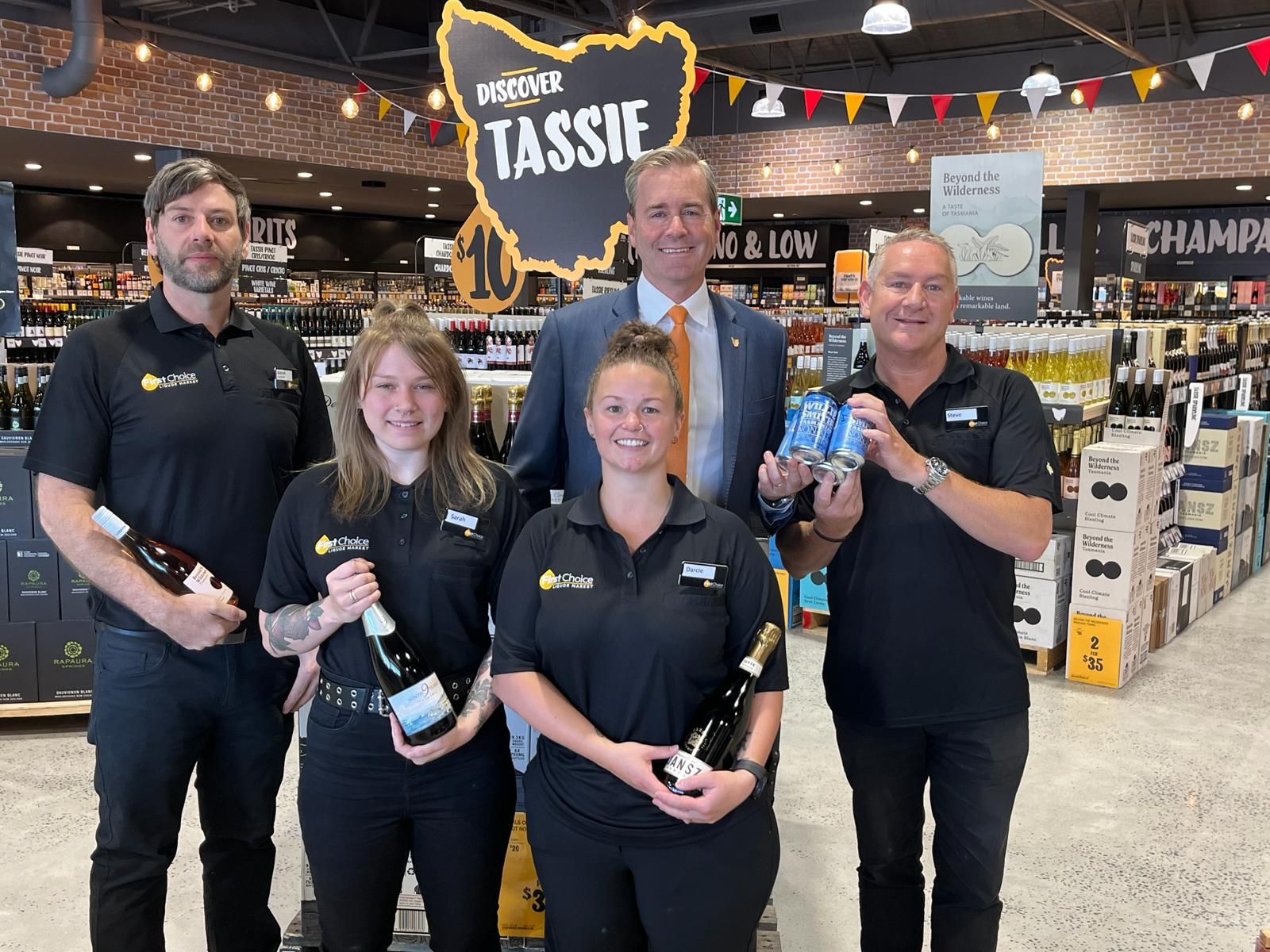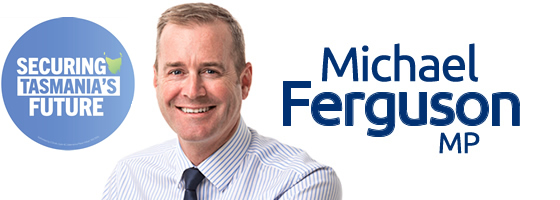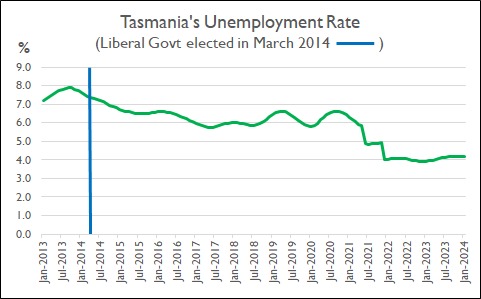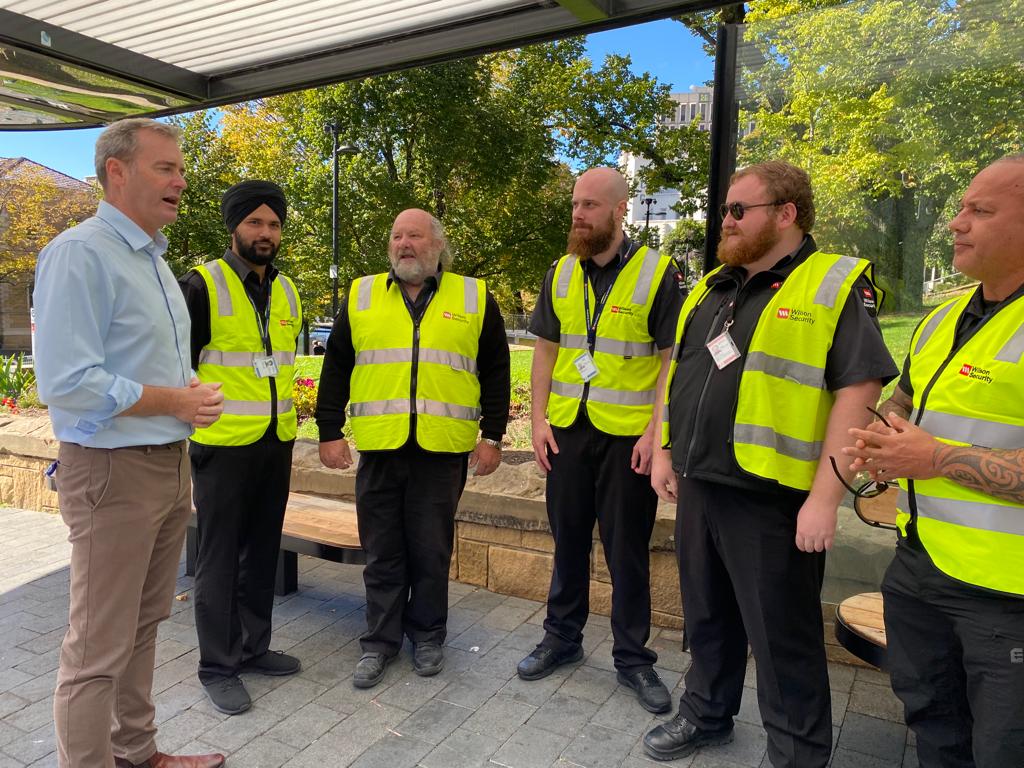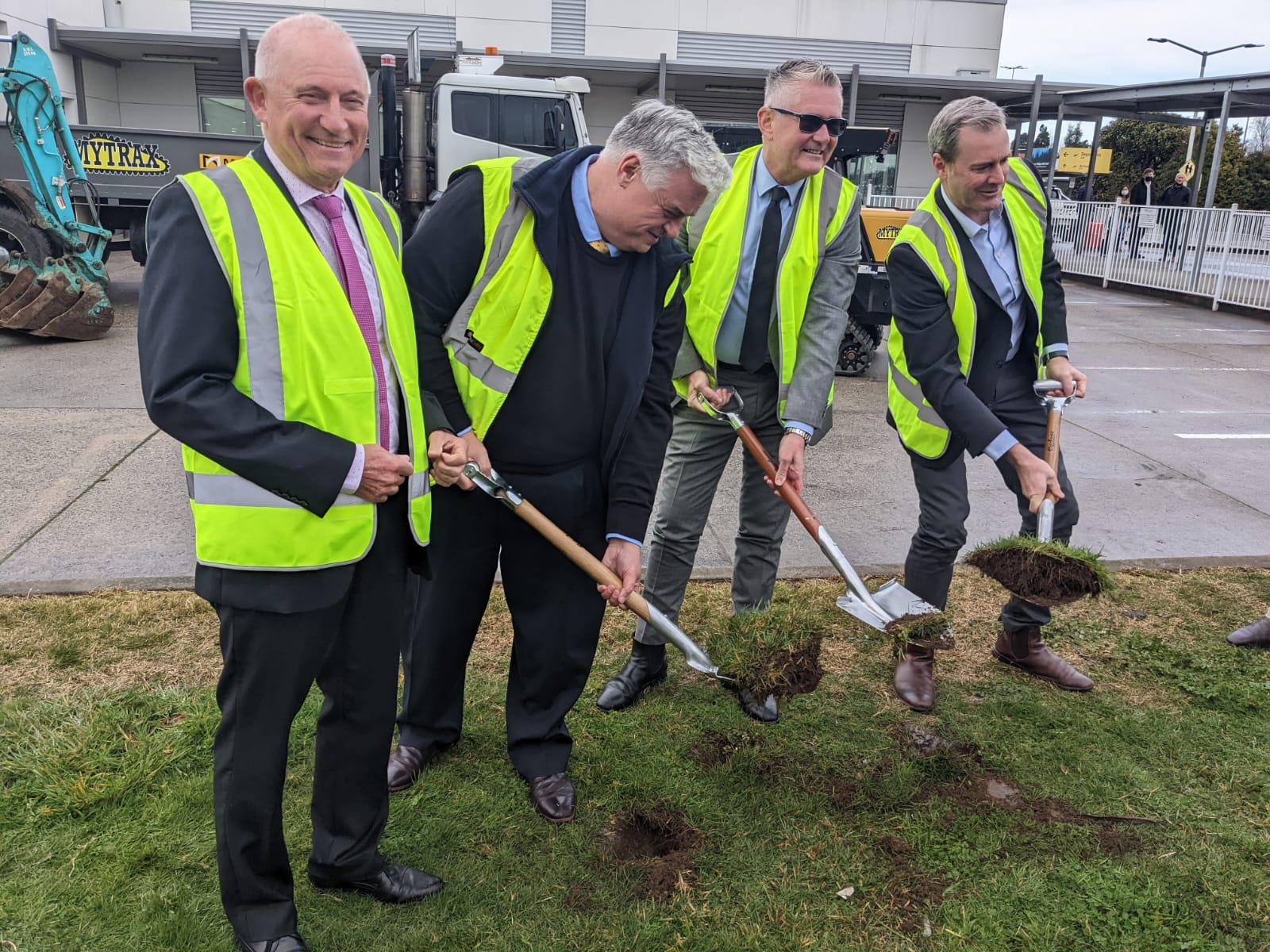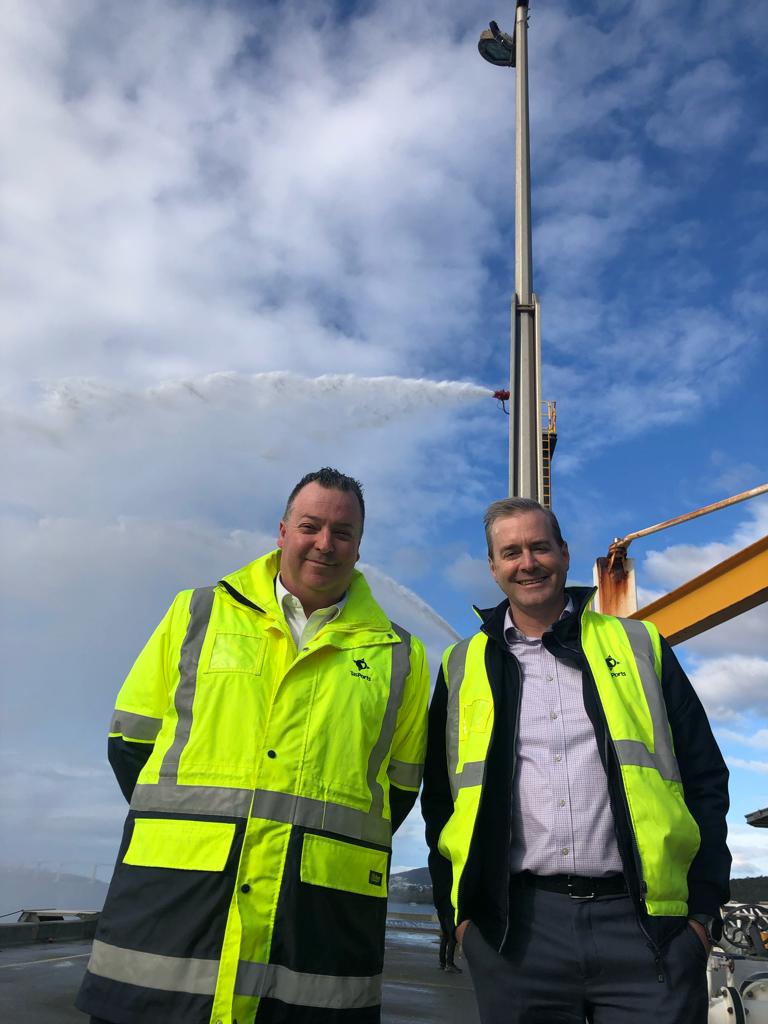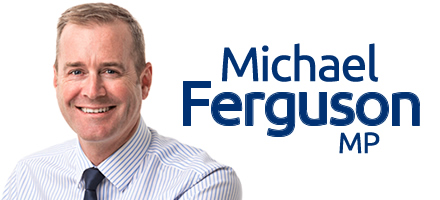
May 27, 2022
Mr Speaker,
Over two years ago, our world faced challenges and uncertainties brought about by the global COVID-19 pandemic. Governments were tested on their agility, responsiveness and leadership.
The Tasmanian Liberal Government took swift action, leading the nation in protecting our community, in business and social supports, and in bold initiatives to rapidly recover and rebuild.
The pandemic caused economic volatility, and we responded with strong actions that secured a more resilient economy.
The challenges are not over, and we must build on the gains made.
As the new Treasurer I intend to continue in the Liberal tradition of the previous eight budgets in building business and community confidence through strengthening our economy and by delivering on our commitments.
This means we can focus on what matters to Tasmanians: health, education, housing, and building safe, inclusive, thriving communities.
The Rockliff Liberal Government’s vision is for Tasmania to be a place where everyone is encouraged and supported to be the best they can be.
To achieve this we will harness our comparative advantages, create more opportunities for Tasmanians, and maintain a robust economy.
The 2022-23 State Budget is about strengthening Tasmania’s future, delivering for all Tasmanians.
Mr Speaker,
Responsible Budget management has been a hallmark of this Government and today’s Budget is built on this foundation.
This has enabled the Government to navigate the worst of the pandemic, providing economic and social support measures in excess of $1.5 billion.
Those measures have worked.
Despite the impact of the pandemic, the Tasmanian economy remains strong.
Since we came to Government 26,000 jobs have been created around the State and the unemployment rate is at 3.8 per cent – the lowest level on record, and half of what it was in March 2014.
Business confidence is up, resulting in more investment and jobs.
Mr Speaker,
For nine consecutive quarters the Tasmanian economy has led the nation in the CommSec State of the State Reports, holding the mantle of the best-performing economy and ranking highly in the key economic indicators.
Tasmanian exports of goods are at record highs, growing by almost 25 per cent to reach $4.6 billion in the 12 months to March 2022.
Retail trade was $665.9 million in March, 15.3 per cent higher than before the pandemic and a staggering 45.4 per cent higher than when we came to Government.
In 2020-21, our economy grew by 3.8 per cent, the second strongest growth in Australia and more than double the growth experienced in the national economy.
In 2021-22, the Tasmanian economy is expected to grow by 3¾ per cent, while State Final Demand is estimated to grow by 6 per cent.
Treasury forecasts that above-average economic growth will continue in 2022-23 and 2023-24.
Having a strong economy has allowed the Government to invest more into health, education, housing and community infrastructure.
It has also given us the capacity to do more in this Budget to keep our children safe and deliver on our commitments.
Mr Speaker,
Although our economy has recovered well from the impacts of the pandemic, the world is currently witnessing a volatile economic environment.
The global economic outlook deteriorated following the invasion of Ukraine and lockdowns in China, affecting key manufacturing hubs and putting pressure on supply chains.
These events have translated into higher costs for Tasmanian households and businesses.
The Government understands the pressure this places on household budgets.
That is why the Budget provides over $305 million in concessions to support vulnerable Tasmanians to meet essential costs of living, including the cost of water and sewerage, electricity and council rates.
It includes $39 million over four years in concessions for water and sewerage bills and, importantly, this concession is indexed annually in accordance with movements in the Consumer Price Index for Hobart to ensure the value of the concession is maintained.
A further $79 million in council rate remissions will be provided over the next four years, while electricity concessions of $186 million will also be provided to eligible concession card holders to help manage their electricity bills.
To ensure the value of the concession is maintained, the electricity concession daily rates are revised annually to reflect any increase in the standing offer prices approved by the Tasmanian Economic Regulator.
Mr Speaker,
We also have amongst the lowest regulated electricity prices in the nation and are working with Aurora not to pass on the costs associated with the Aurora plus App.
Over the past seven years, in real terms, regulated energy prices have decreased by 18 per cent for residential customers and over 27 per cent for small business customers.
The Government is also supporting lower fuel prices through the Fuel Check website and App, which continues to put competitive pressure on fuel prices.
We have also delivered the lowest vehicle registration premiums of all the states and territories and introduced quarterly registration payments to help bill smoothing for households.
Mr Speaker,
This Budget strengthens Tasmania’s future.
Despite the impact of COVID-19 on our economy, we are carefully getting the Budget back on track and into surplus over the Forward Estimates.
In 2023-24 we will return to a Net Operating Surplus of $19.1 million, with $32.2 million in 2024-25 and $30.5 million in 2025-26.
As we transition to living with COVID, the Budget also provides the flexibility needed to ensure we can respond to emerging issues, and for this purpose the Treasurer’s Reserve is maintained at $300 million over the Budget and Forward Estimates.
I have also tasked Treasury with providing advice to me on strategies to ensure our debt levels remain within manageable limits into the future so we can again use our balance sheet to shield Tasmanian jobs and families should external shocks to our economy occur in the future.
Mr Speaker,
Tasmania’s GST share is important for our state and we will not take a backward step in advocating our clear position on this issue.
It has always been the position of our Government that the GST no worse-off guarantee should continue in perpetuity.
As a small state we should not be losing out to other states that are swimming in mining royalties and posting multi-billion-dollar surpluses. This will be a test of the new Federal Government and whether they will govern for all.
It will also be a test for the new government whether it can control national inflation as promised, without reneging on any of the commitments made to Tasmania.
Mr Speaker,
The health of every Tasmanian continues to be our highest priority, and we continue to allocate more funding for health than any previous government.
In this Budget, health expenditure will increase to $11.2 billion and now accounts for 33.6 per cent of the Budget’s total operating expenditure, compared to 28 per cent in 2013-14.
We will spend on average $7.3 million every day on delivering health services to the Tasmanian community.
To meet demand pressures in our hospitals, we are investing a further $50 million to lock in the beds we opened in preparation for border changes last December.
This is complemented with more than $12 million for public-private partnerships to meet demand and the Government’s $196 million state-wide four-year elective surgery plan to deliver more surgeries sooner.
Mr Speaker,
The Government is already investing significantly in community and GP-led healthcare and hospital avoidance programs, and this Budget includes $30 million for the Community Rapid Response Service across the State.
The Budget also invests into our rural hospitals with $17.7 million for the Safe Staffing Model and $3.8 million for additional staff.
As a major initiative, this Budget begins a game-changing investment into digital health, with $150 million allocated over the next four years to continue improving access to healthcare.
This significant investment will provide for a fully integrated health care system, while increasing capacity and efficiency by better connecting our community health care and hospital sectors so more Tasmanians can access the healthcare they need where they need it.
This builds on our Government’s investments in regional telehealth which has been embraced by clinicians and patients.
Mr Speaker,
Like other jurisdictions, demand for ambulance services is increasing and this Budget provides Ambulance Tasmania with $48.6 million for paramedics.
This investment will fund an additional 11 paramedics for the Huonville and Sorell Ambulance Stations, providing fully qualified paramedics crews on duty 24 hours a day, seven days a week.
This builds on the 243 extra paramedics we have recruited since 2014.
Our highly successful southern Emergency Mental Health Co-response model (PACER) pilot has supported over 400 clients, with 74 per cent remaining in the community instead of being transferred to hospital.
We are continuing this important initiative with $9 million and will commence a North West PACER pilot in early 2023 as we move to a state-wide model.
Mr Speaker,
The 2022-23 Budget provides $2.6 million for a new Safety and Quality Team to improve clinical outcomes, and $6.5 million for the continued delivery of the Mental Health Reform Program, including the roll-out of adult Acute Care and Continuing Care models in the North and North West.
We are also continuing to invest $45 million in our Child and Adolescent Mental Health reforms.
This year will see new services established, including a youth forensic service and a specialist service for children in out of home care.
The Budget provides $20 million to continue implementation of the recommendations of the Roy Fagan Centre Review, to further improve patient care through Older Persons Mental Health Services.
Funding of $1.5 million is provided to continue implementation of Tasmania’s overarching mental health plan, Rethink 2020, with a focus on suicide prevention.
Mr Speaker,
We are committed to ensuring those seeking alcohol and other drug treatment can get the right care when and where they need it.
We have allocated $7.5 million over two years to continue the implementation of the Reform Agenda for the Alcohol and Other Drug Sector in Tasmania, and $1.3 million to support the Tasmanian Drug Strategy, to reduce the harms associated with the use of alcohol, tobacco and other drugs.
Mr Speaker,
This Budget includes a significant $654 million investment over the next four years for upgrades at all four major hospitals and investment into rural hospitals and community health services.
With the inclusion of the Government’s investment in digital health, we will invest $1.5 billion into contemporary health infrastructure over the next decade.
Mr Speaker,
This Government is taking unprecedented action to assist more Tasmanians into homes.
While our economy is strong, we also know that many Tasmanians are still doing it tough and there is more work to do.
That’s why this Government is implementing the most comprehensive and ambitious affordable housing strategy in Tasmania’s history.
Through this Budget the Government will invest up to $538 million into social and affordable housing and homelessness initiatives, with $204 million in 2022-23 alone.
We also on track to build 1 500 homes by June next year, rising to a total of 10,000 new homes by 2032 as part of our 10-year $1.5 billion housing package.
We are making good progress in establishing Tasmania’s new Housing Authority, which will be tasked with building and acquiring these homes, as well as partnering with the our community housing partner organisations to increase supply and deliver more affordable homes than ever before.
Mr Speaker,
Our existing measures to build more houses and make it easier to get into the housing market are making a difference to Tasmanians.
We have underpinned new building activity through the ancillary dwellings program, the First Home Owners Grant and the Tasmanian HomeBuilder grant.
More than 1,062 blocks of land state-wide have now been approved under the headworks holiday program, with another 116 currently being assessed.
To further expand land supply, this Budget extends this program, doubling the Residential Land Rebate available from $15 million to $30 million.
Since coming to government, our First Home Owners Grants have helped more than 4,000 mostly younger Tasmanians into their first homes.
In this Budget, we extend the $30,000 First Home Owners Grant to 30 June 2023.
We are also helping Tasmanians on lower incomes buy their own home with enhancements to our shared equity program, which reduces the deposit needed to only two per cent, taking effect in July.
Mr Speaker,
The Government’s ancillary dwelling grant program continues to progress well with over 185 new dwellings being developed under the program as new long-term rental stock.
The Budget provides an additional $2.5 million to the program for a further 250 new ancillary dwellings to add to the rental stock.
The property value threshold for stamp duty concessions has been increased to $600 000 to reflect increases in property prices and ensure assistance is available to those entering the market.
And the Private Rental Incentives Program is being funded with a further $9 million over three years to encourage property owners to make their properties available for rent to low-income households.
Mr Speaker,
The Government continues to invest record amounts into education, skills and training with expenditure in this Budget of over $8.5 billion.
We want all Tasmanians to have the opportunity to gain the skills they need to reach their full potential.
Learning from home throughout the pandemic highlighted the need to be flexible and to ensure students have access to remote learning, and this Budget provides $4 million for more laptops and tablets for students which is in addition to the $1 million already invested in this technology.
Mr Speaker,
After parents and teachers, we know that our school leaders have a big impact on student outcomes, and this Budget provides $5 million to support principals’ professional growth and lead improvements in learner outcomes.
We are also investing $3 million into expanded resources, such as digital materials and online subscriptions, for state library users around the state.
The Government is providing high quality inclusive education for students with disability through the needs-based funding model and will commission an independent evaluation of the model next year, and engage with the new Federal Government on our longstanding concerns about funding distribution.
Mr Speaker,
The Government is investing in the renewal of ageing student and school administration systems with $12 million to replace and modernise digital business systems.
The Budget also allocates $250 million in infrastructure investment for new and upgraded schools around the State to build and improve classrooms and essential facilities. This includes:
• $15 million for the redevelopment of Cambridge Primary School;
• $11 million for the redevelopment of Exeter High School;
• $14 million for the Hobart City High School campuses;
• $22 million for the new Legana Primary School;
• $46 million for the new Brighton High School;
• $18 million for the new K-12 Sorell School;
• $19 million to revitalise Cosgrove High School;
• $24 million for the six new Child and Family Learning Centres; and
• $17 million for the Support School Package including North West Support School.
Mr Speaker,
We want more Tasmanians to access the vocational training they need, and last year’s Budget invested almost $100 million to transform TasTAFE into a Government business that is fit for purpose in our booming jobs market.
Funding of over $37 million was allocated to employ 100 extra TasTAFE teachers and now we’re providing a further $7 million for additional support services for these extra teachers.
An additional $5 million is also provided to complete the development of the Water and Energy Trades Centre of Excellence.
Mr Speaker,
In conjunction with the Federal Government, the JobTrainer Fund has provided low or no fee training places for people looking to upskill or retrain.
This Budget provides a further $8 million to extend the JobTrainer Fund.
Up-skilling people to work in the State’s growing building and construction industry is a priority for the Government.
Our $9 million ‘High Vis Army’ initiative is already supporting Tasmania’s peak industry associations to develop workforce capability through a range of training and skills initiatives.
This Budget provides a further $1 million to support the building and construction industry to attract even more skilled workers to this booming sector.
Mr Speaker,
We are fortunate to live in one of the safest places in the world and this Budget continues investments into our police, justice, corrections and rehabilitation systems.
Since 2014, we have funded an additional 329 police officers, bolstering the frontline and our criminal investigation capability.
This Budget provides $15 million to establish new multidisciplinary centres to ensure victim-survivors of family and sexual violence receive immediate and integrated support in a safe place.
We are also investing in policing infrastructure in our regions with $12.5 million to upgrade the Bridgewater Police Station, $6 million to refurbish the Launceston Police Station, $7.5 million for the new St Helens Police Station and $1 million for the upgrade of Rosebery Police Station.
The Budget allocates $6 million to replace the Automatic Vehicle Location systems, $3.7 million for new forensic scientific instruments, and $760,000 to replace police pistols.
We are also continuing to invest in Tasmania Police’s ICT systems with $39 million provided over the next four years.
$10 million is allocated to the Large Vessel Replacement Program and $8 million to complete the Sorell Emergency Services Hub.
All these investments again demonstrate the Government’s commitment to providing our police and emergency services with the resources they need to protect Tasmanians.
Mr Speaker,
The Government is committed to reducing the rates of criminal re-offending, with a renewed focus on rehabilitation in our corrections system.
We have already invested into more rehabilitation programs in prisons to support successful reintegration into the community.
This Budget also allocates $17 million to complete the new Southern Remand Centre and $13.8 million over four years to support its safe and effective operation.
The Correctional Primary Health Services is allocated $7.5 million to meet staffing recommendations from the Coroner, Custodial Inspectorate and Prisoner Mental Health Taskforce, increasing prisoner and detainee access to mental health services because we know the more services that support rehabilitation, the safer our state will be.
Also, we are investing $3.6 million to replace the mobile duress alarm system and $1.3 million for body scanning technology, while $8 million is provided for critical infrastructure maintenance in our correctional facilities.
Mr Speaker,
Our Safe at Home Family Violence Service System is nationally recognised as an integrated justice response to family violence, and we will invest a further $4.9 million into these services.
$12.5 million is also allocated for the first year of Tasmania’s third Family and Sexual Violence Action Plan, which will build upon and embed the successful initiatives implemented in the first two Action Plans.
Tasmania’s children are so very precious to us all and a critical priority of the Government is to continue the implementation of key recommendations from the Independent Inquiry into the Department of Education’s Responses to Child Sexual Abuse.
Funding of $36.4 million is provided over four years to help keep children safe and to implement all 20 recommendations from the inquiry.
The Budget also allocates $5.4 million for the Child Safety Service, to support improved outcomes under the Strong Families Safe Kids Child Safety Redesign.
$6 million is provided for the continuation of the Transition to Independence initiative, supporting young people exiting care to build independence skills to maintain engagement in education and training.
We are providing $4 million for Intensive Family Engagement Services to ensure the safety of children and to help prevent them from entering statutory care.
$2 million is allocated to the Out of Home Care Accreditation and Carer’s Register to improve standards and monitor progress against the recommendations of the Royal Commission into Institutional Child Sexual Abuse.
Mr Speaker,
Our Government established the Commission of Inquiry in order to ensure our most vulnerable are protected and past wrongs can never be repeated.
We thank victim-survivors, and their families and loved ones, for their bravery in coming forward.
These are challenging and distressing issues to share, but these stories must be heard, and the lessons need to be learned so we can ensure children and young people in this State are safe and have the best possible start in life.
With the Commission’s hearings underway, we must allow the process to take its course, independent of Government.
I reiterate our steadfast commitment to acknowledging past failures of governments, going back decades, to ensure the future protection of our children and young people. The Government will continue to respond to what we hear through the Commission, and to its recommendations in due course.
This Budget provides an additional $2.2 million towards the whole-of-government coordinated response to the Inquiry.
This is in addition to the over $10 million already committed for the establishment and conduct of the Commission’s important work – and as Treasurer I will ensure the Commission is fully funded to undertake its work, whatever is required, remembering always that our children are precious and deserve our love and protection.
Mr Speaker,
The Government initiated the comprehensive review into the Public Trustee late last year.
While the findings were tough to hear, the review provided an opportunity to continue to improve its processes and provide better client focus.
To support the transition, the Budget provides $4.3 million over four years to implement the Review’s recommendations and a further $4.3 million to meet the costs associated with the delivery of the Public Trustee Community Service Obligation.
The Government is also reviewing Local Government to create a more robust and capable system of local government that is ready for the challenges and opportunities of the future.
Funding of $1.6 million is provided for this review. The Local Government Board will provide recommendations on the future role, functions and design of local government, and the structural and legislative reforms required to meet these objectives.
The Government is also committed to implement the findings of the independent review of the Tasmanian State Service and $2 million has been provided for this purpose.
Mr Speaker,
The Budget also allocates funds to a number of our key statutory offices including:
• $900,000 for the Integrity Commission for education and oversight functions;
• $1.2 million for the Office of the Ombudsman to improve health complaints resolution;
• $7.6 million for the operation of the Tasmanian Civil and Administrative Tribunal; and
• $400,000 to further support the establishment of the new Tasmanian Disability Commissioner.
Mr Speaker,
The Government is committed to delivering better outcomes for Tasmanian Aboriginal people by working in partnership to close the gap, protect culture and heritage and co-design our next steps towards reconciliation.
This Budget provides an additional $2 million for Tasmania’s Closing the Gap Implementation Plan.
This funding will focus on building the capacity of Aboriginal Community Organisations across Tasmania to better meet the needs of Aboriginal people.
The Budget also supports an expanded program of cultural burning in partnership with Aboriginal Community Organisations, with the provision of $1.3 million over the next four years.
Within health, $1.5 million is provided to implement our Action Plans for Improving Aboriginal Cultural Respect across Tasmania’s Health System, supporting improved health outcomes for Tasmanian Aboriginal people.
And an allocation of $500,000 will be provided to support the next steps towards truth-telling and treaty, through processes co-designed with, and led by, Tasmanian Aboriginal people.
Mr Speaker,
For the first time, this year’s Budget includes a Gender Budget Statement.
This statement is one way we can highlight our policies, and the actions we are taking, to create a more inclusive Tasmania.
To support this work, $800,000 is allocated to the Tasmanian Women’s Strategy, which will guide our work for gender equality.
Funding of $740,000 is allocated to develop a Women and Girls in Sport Strategy to provide clear and effective strategic leadership for increasing female participation in sport.
We are investing $450,000 to support increased gender and cultural diversity across our resources sector and a further $450,000 to promote women’s leadership in hospitality.
Mr Speaker,
Our State is stronger and more prosperous because of our vibrant and diverse community, and we want to ensure Tasmanians of all cultures and backgrounds have equal opportunity to contribute and succeed.
To progress these aims, the Budget provides $180,000 for the Tasmanian Multicultural Policy and Action Plan.
Volunteers are the backbone of our communities and $440,000 will be provided to support Volunteer Tasmania’s Safeguarding Volunteer Project.
The Council of the Ageing Tasmania has been allocated $1.2 million to continue coordinating Seniors Week and implement activities under the Active Ageing Plan.
With the construction of the new Devonport Men’s Shelter on track for completion by January, the Budget provides $2.5 million for its operation.
Mr Speaker,
The success of the JackJumpers has reinforced the value of sport in our community.
$1.25 million is provided in the Budget for the AFL Team Taskforce and Stadium Feasibility Study, to enable the important work of the AFL Licence Taskforce.
Funding of $1.5 million is also allocated to Stadiums Tasmania to develop a 10-year statewide stadium plan.
The Budget provides $1 million over the next four years to support the staging of the Ironman 70.3 Tasmania event in Hobart, which is expected to attract more than 3,000 visitors when the first event is held in February.
$400,000 is provided for a mountain bike pump track at St Helens on the East Coast and $964,000 is allocated to the Cadet Stipendiary Steward program to provide career pathways for young people wanting to work in Tasmania’s racing industry.
Mr Speaker,
This Government understands the importance of building the economy and supporting our industries and businesses, both large and small, to be confident, sustainable and competitive.
That is why this Budget leverages our comparative advantages by providing:
• $1 million for power network upgrades to support the historic re-opening of the Dolphin Mine on King Island;
• $800,000 to enable Mineral Resources Tasmania to provide enhanced services and information to our growing minerals and construction sectors;
• $2 million to support the enhanced role of Infrastructure Tasmania in delivering government infrastructure projects;
• $377,000 to develop a new Ten-Year Salmon Plan allowing industry and the community to identify new long-term actions for a successful and sustainable industry;
• $400,000 for the ShellMAP Industry Market Access Program;
• $1.9 million for the implementation of the Wild Fallow Deer Management Plan;
• $200 000 for the Resource Security in the Forestry Sector initiative to inform the Government’s strategic approach in achieving long-term sustainable wood resource security; and
• $535,000 for the National Water Grid Authority Science Program, to encourage the environmentally conscious, sustainable use of water and promote innovation and growth.
Mr Speaker,
As international borders re-open, now is the time to take Tasmanian products to the world.
The Budget allocates $1.8 million for the 2024 Trade and Investment Mission to showcase the products of Tasmanian exporters and continue growing our export markets.
Tasmanian products are prized for their high quality right around the world and attract a premium price.
To better promote Tasmanian products, Brand Tasmania is allocated $500,000 to establish the Tasmanian Mark Certification Scheme, which will be used to promote our unique products, goods and services.
We are not only looking beyond our shores, but we are also looking to the skies.
The Budget allocates $500,000 for the Tasmanian Space Technology Seed Fund, which will support the growth and development of Tasmania’s emerging space industry, funding research and development projects for the space economy.
Mr Speaker,
Tourism is a vital part of the Tasmanian economy, especially in our regions.
In recognition of the importance of Tasmania’s tourism sector, the Budget provides $10 million to secure the sector’s continued recovery from the impact of the pandemic and maximise Tasmania’s resurgent visitor economy.
Tasmania welcomes around 20,000 visitors from New Zealand each year and we expect this to increase through the introduction of the new direct flights.
We are providing $2 million for Inbound Tourism Support to enable Air New Zealand to deliver a direct service between Hobart and Auckland.
Mr Speaker,
The Government is committed to protecting our environment and promoting the benefits of primary industries and agriculture in Tasmania.
This Budget allocates $8 million to Tasmania’s independent Environment Protection Agency to perform environmental assessments, whilst also providing a further $2 million to meet operational costs.
This Budget provides $3.3 million to implement the Tasmanian Wilderness World Heritage Area biosecurity strategy to respond to the threat of invasive weeds, animals and diseases.
In addition, $1.3 million is provided to strengthen biosecurity on the Bass Strait Islands by funding full-time officers on Flinders and King Islands.
With a Budget allocation of $6.5 million, the Reserve Activity Assessment Reforms Project will enshrine in legislation an independent panel to assess and review significant proposals, a process for administrative appeals and the publication of leases and licences.
Mr Speaker,
The Royal Tasmanian Botanical Gardens is the second oldest botanic gardens in Australia and it’s a show piece for the State’s precious flora.
To continue to sustain the Gardens, an additional $1 million is provided over four years to meet its operating costs and to fund a review of the Garden’s Strategic Master Plan.
The Budget also allocates $300,000 to support the operations of the National Trust in managing its heritage properties and to facilitate strategic business transformation activities.
Mr Speaker,
The findings of the Royal Commission into National Natural Disaster Arrangements were delivered in October 2020 and the Government welcomed the report.
Consistent with the recommendations, we’ve increased resourcing for bushfire risk mitigation, and we are investing in indigenous fire management as well as further research into natural disasters, compound events and resilience.
In this Budget, a further $5 million is provided to implement the Commission’s recommendations.
The Budget also includes $144 million for maintenance, restoration and upgrades of our parks and reserves infrastructure, including $18.7 million for the Next Iconic Walk in the Tyndall
Range on the stunning West Coast.
Mr Speaker,
We will strengthen Tasmania’s future by investing to grow and diversify our economy and build its resilience.
We are powering ahead to meet our ambitious climate and renewables targets: net zero emissions or lower, from 2030, and 200 per cent renewable by 2040. These targets will drive productivity and economic growth, demonstrate leadership, and diversify our economy into new industries and opportunities.
Tasmania is a leader in climate change action, having achieved our target of net zero emissions in six of the last seven years. And in November 2020, Tasmania achieved 100 per cent self-sufficiency in electricity from renewable sources.
Tasmania’s enviable emissions profile will deliver brand benefits and generate investment and jobs.
The Budget includes $800,000 to implement the recently released Renewable Energy Coordination Framework, which prioritises the actions necessary to support the future growth of renewable energy sector.
We will invest a further $2.3 million towards transitioning the Government fleet to electric vehicles by 2030, reducing our dependence on imported fuels, increasing demand for our renewable energy and reducing emissions and operating costs. This has the added benefit of bringing more electric vehicles to the Tasmanian used car market.
The Budget also includes $9.8 million to support our nation-leading target of net zero emissions from 2030, and towards our next Climate Change Action Plan to identify practical actions to reduce emissions.
Mr Speaker,
We are also well on the way to implementing the historic agreement we made with the Australian Government to deliver Marinus Link and Battery of the Nation.
Working with our Government businesses we will match the Australian Government’s funding to support Marinus through to Final Investment Decision, while Hydro Tasmania will also provide up to $58 million for Tarraleah Power Station, as part of the broader Battery of the Nation project.
And our bold plan to be a globally significant producer of green hydrogen from 2030 is also gaining momentum, with Bell Bay in Northern Tasmania the perfect location for a nation-leading green hydrogen hub.
Mr Speaker,
In our growing State, the Government is continuing to invest in next-generation infrastructure for Tasmanians, which builds better communities, provides better services, opens more opportunities and creates more jobs.
The Government will invest a record $5.6 billion over the next four years in infrastructure for our hospitals, schools, and communities.
In addition to the health, education and housing infrastructure already outlined, we are investing $222.9 million into critical infrastructure in our law and order system, including $91 million towards the new $270 million Northern Prison and $37.5 million for the Burnie Court Complex.
We are again making record investments into our roads and bridges with $2.7 billion this Budget.
This investment includes $731 million for the new $786 million Bridgewater Bridge, which has now received planning approval, demonstrating the first use of the Major Projects legislation and removing the final hurdle to construction starting this year.
The Budget invests $633 million over the next four years for Roads of Strategic Importance right around the State, while also providing an $81.5 million boost in maintenance of the State’s network of roads and bridges, lifting the total maintenance spend by more than 26 per cent to $388.5 million over the next four years.
The Budget continues to provide funding for other critical road infrastructure including:
• $166 million to progress the Greater Hobart Traffic Solution;
• $112 million towards the ongoing improvement of the Midland Highway;
• $85 million for the Urban Congestion Fund;
• $60 million to continue implementing the Launceston and Tamar Valley Traffic Vision;
• $51 million for the South East Traffic Solution;
• $42 million for the Algona Interchange and Kingston Bypass duplication; and
• $22 million for the Channel Highway bypass of Huonville.
Importantly, $64 million is provided for Road Safety Projects, while $17 million is allocated to new Park and Ride facilities to give commuters choice and reduce congestion.
Mr Speaker,
The Government delivered a trial of our new Bellerive-Hobart ferry last year and it has proven a great success with around 600 passengers per day using the service through the summer period.
This Budget provides $19 million over the next four years to lock in this exciting new service between Hobart and Bellerive so that our recent success is made permanent.
The initiative also includes funding for the design and construction of a floating pontoon at Bellerive and infrastructure to improve all weather passenger amenity and the general upgrade of the wharf area.
Mr Speaker,
This is a deliberately comprehensive Budget, a responsible Budget, a Budget that shows in detail that we can lead with both our hearts and minds, to secure a future that delivers for all Tasmanians.
It is about listening to Tasmanians and making their priorities, our priorities.
It is about investing in the future, using our strengths and building on the strong foundations we have established since 2014.
The Rockliff Liberal Government understands the current pressures on household budgets from tragic, unjust, and complex world events beyond our control.
We also understand the supports that families need.
And because of our responsible management, we are getting the Budget back on track and providing those supports.
Mr Speaker,
I commend the Bill to the House.
